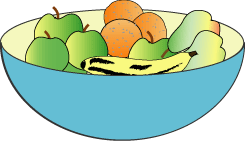A bowl of fruit
Can you work out how many apples there are in this fruit bowl if you know what fraction there are?
Problem
Here is a bowl of fruit.

Half of the pieces of fruit in the bowl are apples. There are also $3$ oranges, $2$ pears and a banana.
How many apples are there in the bowl?
If, instead, one quarter were apples and one quarter were oranges and there were also $4$ bananas, $3$ pears and $3$ plums how many would be apples?
Getting Started
In total, what fraction of the fruit in the bowl are oranges, pears and bananas?
How many pieces of fruit which are not apples are there altogether?
In the second part of the problem, what fraction of the fruit in the bowl are bananas, pears and plums?
How many bananas, pears and plums are there altogether?
Teachers' Resources
Why do this problem?
Possible approach
Key questions
What fraction of fruit in the bowl is not apples?
Possible extension
Possible support
Those experiencing difficulty with this problem may find it easier if they use this sheet along with counters to represent the fruit.
